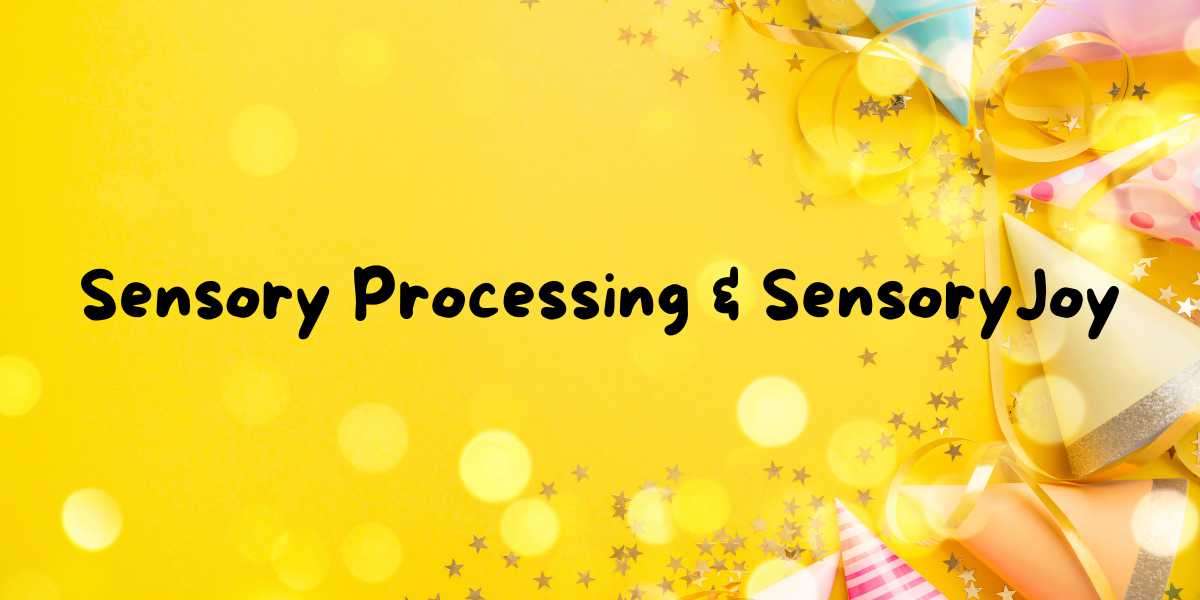Hi {$name}
Today let's look at sensory processing in a different light. Instead of viewing it through the lens of challenges and how to fix them, let's explore the idea of sensory processing as a source of joy for your child.
But before I do, I'll start with a quick blurb on what is sensory processing in case this is new to you. And at the end, you'll find how you can learn more about it.
What is Sensory Processing?
Sensory processing refers to how one takes in information from their senses (e.g. touch, sight, sound, movement); how their brain interprets it; and how that then affects your movement, play, learning, interaction, and daily life.
Discovering Your Child's Sensory Joys
Usually, when we think of a child's sensory processing, we often focus on their struggles and sensitivities because they can't tolerate loud or busy places, panic with movement, have meltdowns, or constantly fidget and wiggle their bodies.
Today let's dive into this idea of 'sensory joy' as a way to help kids:
*feel comfortable in their bodies
*find joy by feeling (or sensing) what makes them feel good
*look after themselves with self-compassion
How do you start?
First, note you have 8 senses:
Tactile - touch
Proprioception - muscles and joints, feeling where your body is
Vestibular - movement
Auditory - sounds
Visual - sights
Taste
Smell
Interoception - how your insides feel (
Secondly, notice what truly feels good to your child and even yourself in regards to each of these senses. Talk about your sensory preferences with your child. Show them how you use your sensory preferences to feel happy or to find restoration.
These sensory activities don't necessarily have to be calm or quiet only as for some people, they feel sensory joy from moving, swinging, and physical exercise.
Here are some examples of sensory joy for each sense:
- Tactile: Does your child like bear hugs, gentle rubs, or light stroking?
In regards to tactile objects, do they like scratchy bristle brushes, a soft velour fabric, warm beanbags, or sequinned items? - Prop: Do they like weighted items like weighted toys to carry or weighted blankets for comfort? Do they like physical activity where they feel their muscles and joints more such as through climbing, jumping, or hanging?
- Visual: Do they like screens, kaleidoscopes, reading, or perhaps even having 'less' visual stimuli around?
- Auditory: Do they prefer quiet or background sounds? Consider music, quiet, soothing background sounds, or some prefer louder music on.
- Movement: Do they find movement either calming or alerting? E.g. Rocking chairs, swings, or simply going for a walk.
- Taste: Are any flavours joyful or comforting for your child? E.g. For me, noodle soup is my comfort food.
- Smell: How do they like scents like vanilla pods, lavender, or other fragrances?
Lastly, find ways to use sensory joy in your lives to fill your cup.
The Connection to Learning and Writing
You might be wondering how all of this ties into learning and writing. Well, the first step in helping your child who struggles with writing is for them to feel good about themselves and feel safe and happy. Sensory joy and self-care provide the foundation for this.
The second step involves helping kids feel more comfortable with their bodies and mind to do what's meaningful for them. This is where we adapt the environment so kids can cope more, but also, where we figuring out how to build these skills while staying within their window of tolerance.
We'll be discussing how sensory processing impacts coordination, emotions, learning and writing in the upcoming free "Beyond Pencil Grasp" workshop.
Know the steps to take to help them not only get comfortable writing, but to choose to write. Most parents are relieved to learn The No Writing Way™ so they can see their child’s writing improve without doing pencil and paper tasks.
Beyond Pencil Grasp
Workshop + QA
Sat 20th jan at 8pm (UK time)
Live + Replay Available
Cost: Free
www.subscribepage.com/beyondpencilgrasp
Munira is a paediatric Occupational Therapist and owner of ot4kids Ltd. She has been supporting neurodivergent kids’ sensory processing, coordination and writing for 25 years.
Being a mum herself, she loves helping parents feel empowered, inspired and hopeful to help their kids’ skills for writing.
She is a huge believer in getting to the root cause of a child’s difficulties and starting from where they’re at to develop the underlying skills they really need. This is why she uses the No Writing Way™ to help kids write in her Foundations for Writing program. She’s also host of the Helping Kids Write FB group for parents.
www.facebook.com/groups/helpingkidswrite
Munira is also a home educating mum to her son, and playing piano and guitar, traveling and going on foodie adventures.








